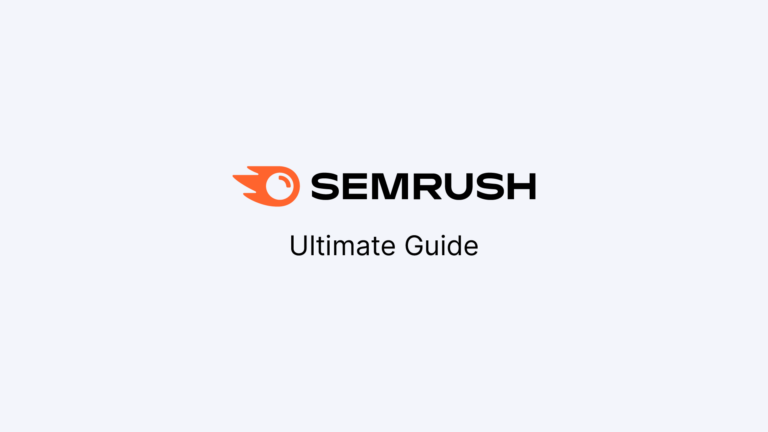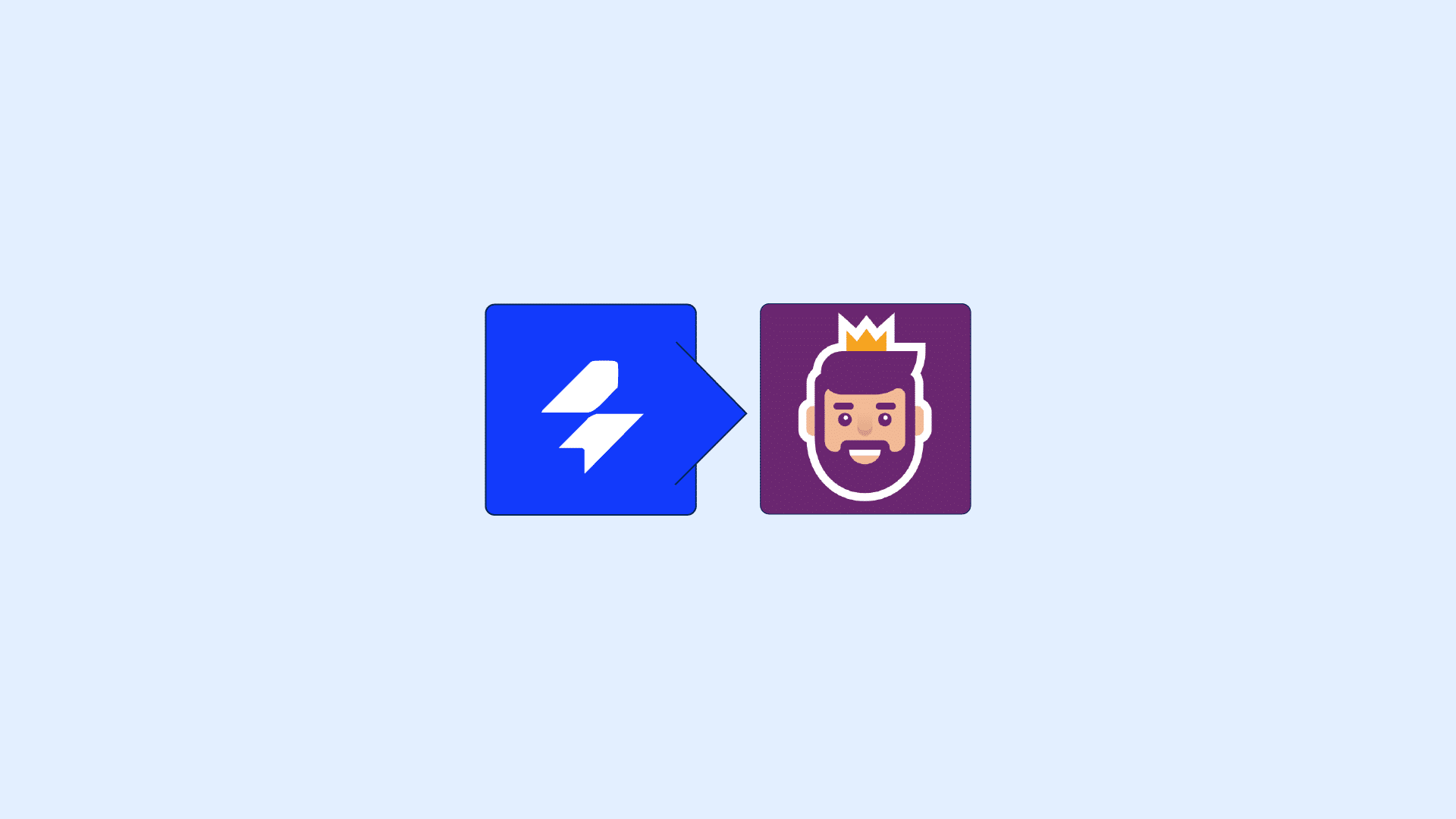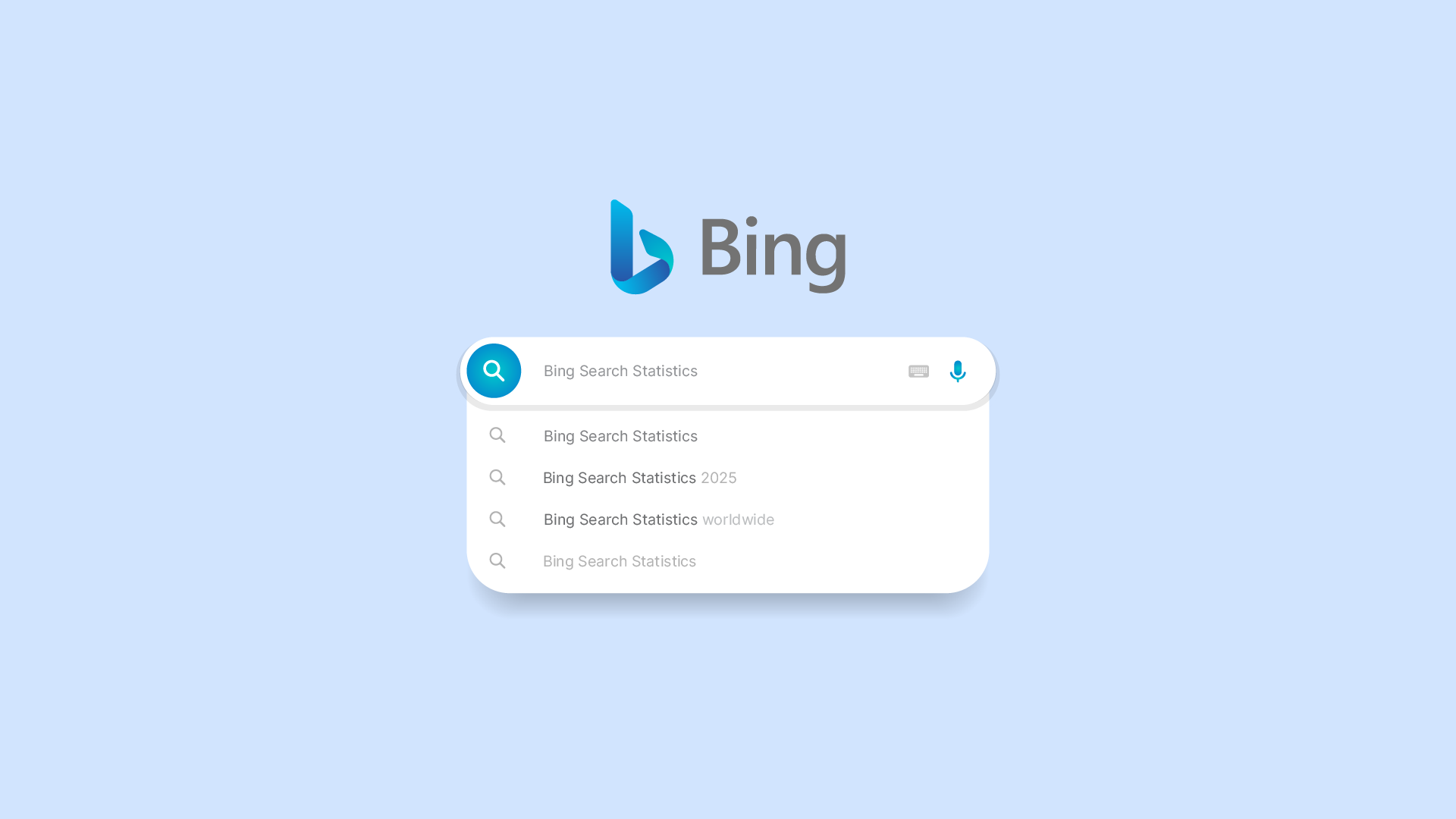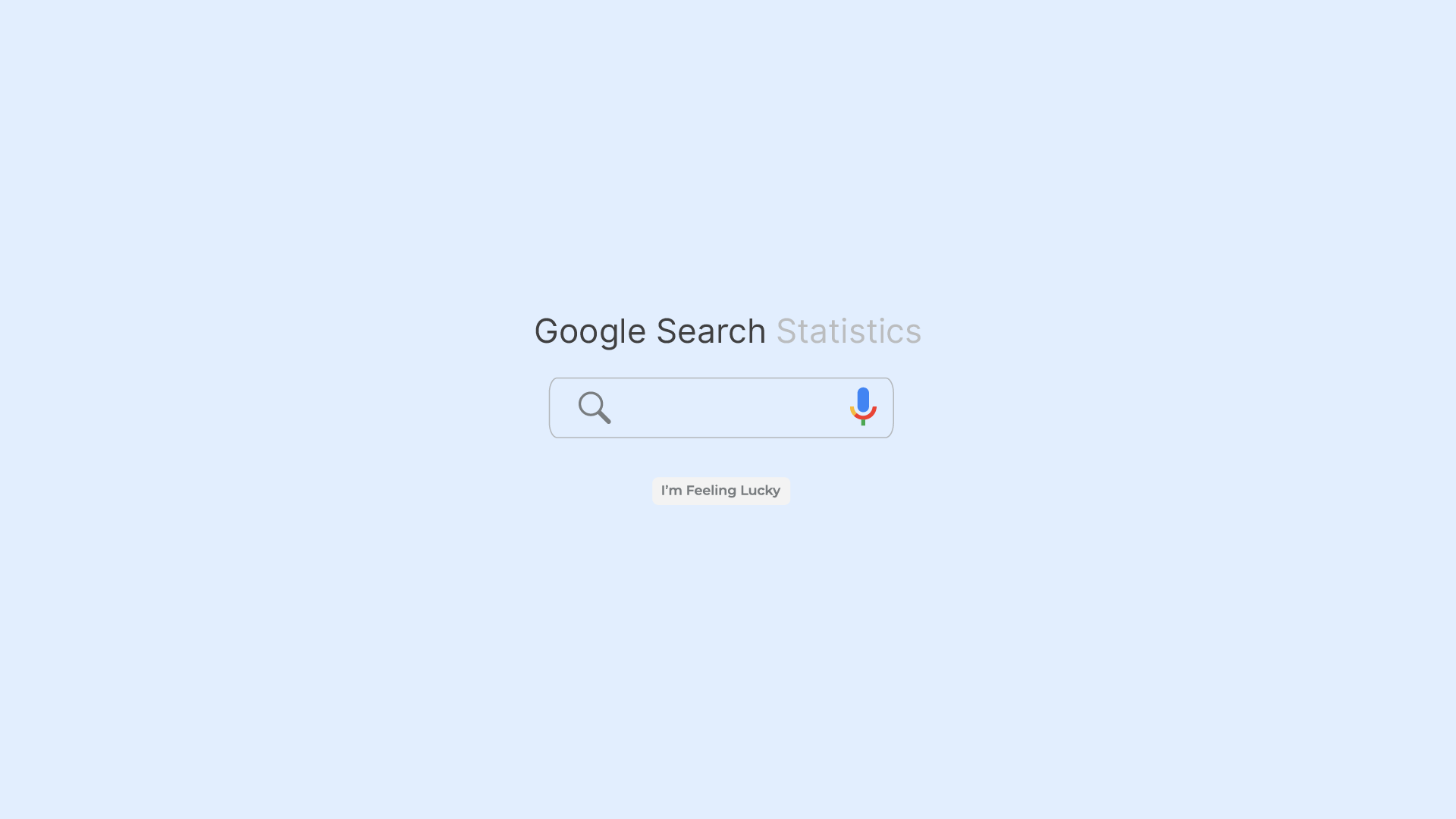Semrush is far more than just a suite of SEO tools; it’s a robust all-in-one platform designed to help you dominate the online marketing landscape.
Since its inception in 2008, Semrush has evolved into a powerful Software-as-a-Service (SaaS) solution trusted by digital marketers, SEO specialists, and businesses of all sizes around the globe.
Whether you’re a solopreneur looking to optimize your site’s presence or part of a large agency managing complex marketing campaigns, Semrush provides vital insights and tools that can help you stand out in today’s competitive market.
In this guide, we’ll walk you through the ins and outs of Semrush—everything from its origins as an SEO competitor research tool to the suite of features that can transform your approach to search, social media, and content marketing.
- What to Expect in this SEMrush Guide
- What Is Semrush?
- Understanding SEO Fundamentals
- SEO Dashboard
- Competitive Research
- Keyword Research
- Position Tracking
- Organic Traffic Insights
- Link Building
- On Page & Tech SEO
- Local SEO
- PPC Advertising
- Social Media
- Content Marketing
- Semrush .Trends
- Agency Solutions
- Semrush App Center
- Who Is Semrush For?
- Semrush Pricing Plans
- Try Semrush for Yourself
What to Expect in this SEMrush Guide
You’ll discover how to leverage Semrush’s 55+ specialized tools to gain a significant edge on your competitors, improve your website’s visibility, and drive more qualified traffic. One such tool is the keyword overview tool, which aids in keyword research and analysis by tracking various SEO metrics, identifying search intent, and generating keyword ideas.
Additionally, the advertising research tool is essential for analyzing competitors’ PPC performance, including ad spending, successful ad copies, and keyword strategies.
Above all, Semrush is about making informed, data-driven decisions. Through keyword research, competitor analysis, site audits, and more, Semrush empowers you to make strategic tweaks to your digital footprint.
Keyword research tools like Semrush assist users in conducting effective keyword research by analyzing extensive databases of search terms, tracking keyword popularity, and offering features that aid in identifying the best keywords for optimizing search engine performance.
Let’s explore Semrush, why it’s the go-to choice for marketers worldwide, and how you can master each feature.
What Is Semrush?
Semrush is a Software as a Service (SaaS) platform that provides a range of tools for SEO, PPC, social media marketing, content marketing, organic search, and more.
You can use Semrush for everything from discovering new target keywords to monitoring your social media presence. Integrating relevant keywords into your content is crucial for SEO optimization strategies. Think of it as a digital marketing ‘swiss army knife’ rather than a single-purpose tool.

One of the standout features of Semrush is its comprehensive keyword research capabilities. Conducting keyword research using Semrush enables users to identify niche topics and track related keywords, which is essential for understanding competitive landscapes.
Understanding search intent is essential in creating content that aligns with user queries.
This helps ensure that your content matches what users are actively seeking, thereby increasing the likelihood of ranking well in search results.
History and Development of Semrush
Semrush was founded in 2008 by Oleg Shchegolev and Dmitry Melnikov.
Initially, the platform was designed to provide keyword research, SEO tools, and competitor analysis tools for digital marketers. Over the years, Semrush has evolved to include a wide range of features and tools, making it one of the most popular and widely used digital marketing platforms in the world.
The keyword research process has been significantly enhanced with the development of Semrush’s tools, which allow users to filter by keyword difficulty and search intent, and track website rankings in search engine results pages (SERPs).
From its humble beginnings as a keyword research tool, Semrush has grown into a robust platform that supports various aspects of digital marketing, helping businesses of all sizes achieve their online goals.
Toolkits
SEO (the most popular)
Pay-Per-Click (PPC) advertising
Optimize your Google Ads campaign through various tools designed to enhance performance and effectiveness. Analyze competitors’ past ads and utilize tools for keyword management to craft well-structured campaigns that directly inform ad strategies.
Utilize the PLA Research tool to optimize Google Shopping ad campaigns. This tool allows advertisers to analyze competitors’ shopping ads, including target keywords and ad positioning, aiding in strategizing and improving one’s own advertising efforts.
Social media marketing
Content marketing
Management
Agency growth
Within these toolkits, you’ll find dedicated features that help you improve domain visibility, conduct competitor research, perform site audits, and track keywords.
Key Features and Benefits
Semrush is an all-in-one digital marketing platform that offers a wide range of features and benefits designed to enhance your online presence. Here are some of the standout features and benefits that make Semrush an indispensable tool for digital marketers:
Keyword Research: Semrush provides a comprehensive keyword database that helps you identify the most relevant and high-traffic keywords for your business. This is crucial for optimizing your content and improving your search engine rankings.
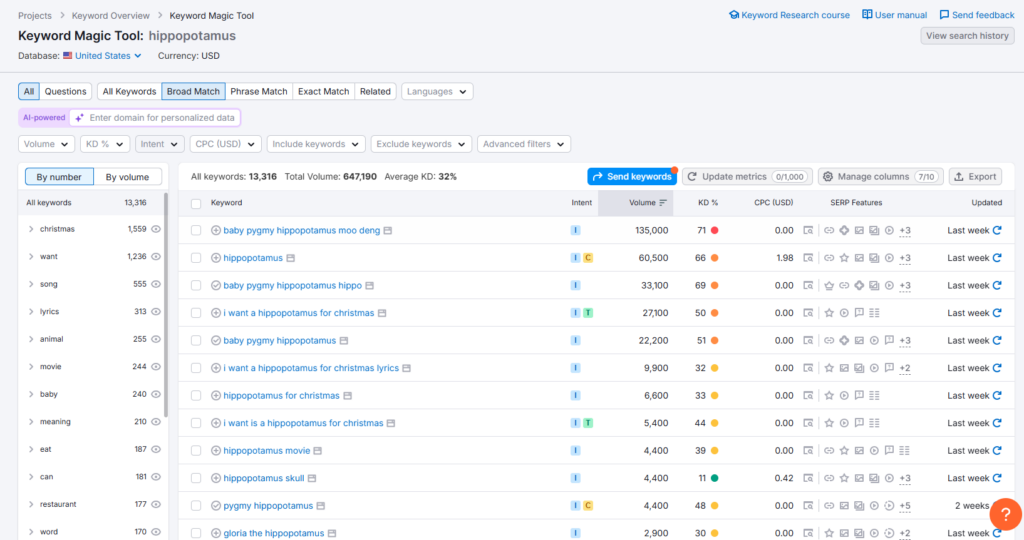
Competitor Analysis: With Semrush, you can analyze your competitors’ websites to uncover gaps in the market and identify opportunities for growth. This feature allows you to stay ahead of the competition by understanding their strategies and performance.
Technical SEO Audit: The technical SEO audit tool helps you identify and fix technical issues on your website, ensuring it is optimized for search engines. This includes checking for broken links, duplicate content, and slow page speeds.
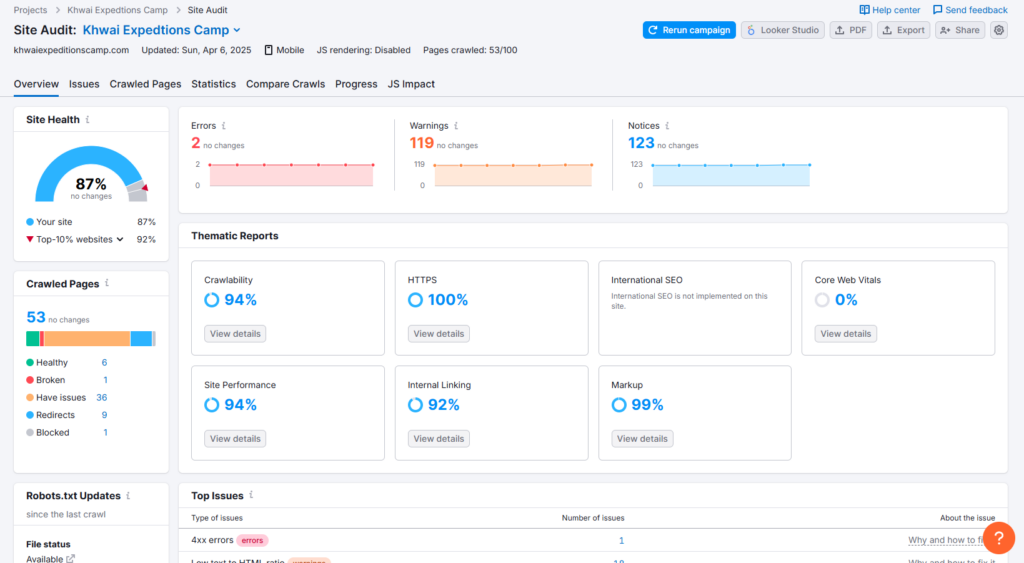
The site audit tool automates audits, identifies errors affecting SEO performance, and provides a comprehensive overview of site issues, including a Site Health Score.
The technical SEO health score helps prioritize fixes and make informed decisions to enhance your site’s overall SEO performance.
Content Optimization: Semrush offers a content optimization tool that helps you create SEO-friendly content. It provides recommendations for keyword usage, text length, readability, and more, ensuring your content is both engaging and optimized for search engines.
Backlink Analysis: The backlink analysis tool allows you to identify and analyze your backlinks. Understanding your backlink profile is essential for improving your site’s authority and search engine rankings.
Local SEO: Semrush’s local SEO tool helps you optimize your website for local search, making it easier for local customers to find your business. This includes managing your Google Business Profile and ensuring your business information is consistent across directories.
PPC Advertising: The PPC advertising tool helps you create and manage your Google Ads campaigns. You can analyze your competitors’ ad strategies, identify high-performing keywords, and optimize your ad spend.
Social Media Management: Semrush offers a social media management tool that helps you manage your social media presence. You can schedule posts, track engagement, and analyze your social media performance across multiple platforms.
By leveraging these features, you can develop a comprehensive digital marketing strategy that drives traffic, improves visibility, and boosts your online presence.
Understanding SEO Fundamentals
What Is SEO?
Search Engine Optimization (SEO) is the process of improving the quality and quantity of website traffic by ranking higher in search engine results pages (SERPs) for specific keywords or phrases.
SEO involves understanding how search engines work, what people search for, and the keywords and phrases they use. By optimizing your website for search engines, you can attract more organic search traffic, improve your online visibility, and ultimately drive more conversions and revenue.
Using tools like Semrush to perform keyword research is crucial for effective SEO, as it helps track SEO health, analyze competitor strategies, and optimize campaigns through comprehensive analytic insights.
Why Is SEO Important?
SEO is important because it helps businesses and individuals increase their online visibility, drive more traffic to their website, and ultimately, increase their revenue.
By optimizing their website for search engines, businesses can improve their search engine rankings, increase their brand awareness, and establish themselves as authorities in their industry.
Effective SEO strategies can lead to higher search engine rankings, more organic search traffic, and a stronger online presence.
Understanding Search Intent
Search intent is the underlying goal behind a user’s search query. It’s what the user is trying to accomplish or find when they enter a search query into a search engine.
Understanding search intent is crucial for SEO because it helps you create content that resonates with your target audience and meets their needs.
There are three main types of search intent:
Informational Intent: The user is looking for information on a specific topic. For example, they might search for “how to do keyword research” or “what is search engine optimization.” Content that addresses informational intent should be educational and provide detailed answers to the user’s questions.
Navigational Intent: The user is looking for a specific website or webpage. For example, they might search for “Google Search Console login” or “Semrush blog.” Content that addresses navigational intent should help users quickly find the specific page or site they are looking for.
Transactional Intent: The user is looking to make a purchase or complete a transaction. For example, they might search for “buy Semrush subscription” or “best SEO tools 2023.” Content that addresses transactional intent should be persuasive and include clear calls to action to encourage conversions.
To understand search intent, you can use tools like Semrush to analyze search queries and identify patterns.
Semrush’s keyword research tools can help you determine the intent behind specific keywords by analyzing search volume, keyword difficulty, and related queries.
Additionally, Google Trends can provide insights into trending topics and what people are currently searching for.
By aligning your content with the search intent of your target audience, you can improve your chances of ranking well in search engine results pages (SERPs) and driving more relevant traffic to your website.
How Do You Make Sure Google Can Index Your Site?
To ensure that Google can index your site, you need to make sure that your website is crawlable, indexable, and optimized for search engines. This can be done by:
Creating a sitemap and submitting it to Google Search Console
Optimizing your website’s structure and content for search engines
Using keywords and phrases that are relevant to your business and target audience
Building high-quality backlinks from other websites
Regularly updating and refreshing your website’s content
Conducting an SEO audit to identify and fix issues that may prevent Google from indexing your site
Integrating a Google Search Console account with Semrush’s Backlink Audit tool to access recent backlink data
By following these steps, you can ensure that Google can index your site and improve your search engine rankings. Ensuring that your site is properly indexed is crucial for achieving higher visibility in search engine results pages and driving more organic search traffic to your website.
SEO Dashboard
The SEO Dashboard is where you can get an at-a-glance overview of your site’s current performance.

From here, you can dive into dedicated areas covering metrics like organic search, organic traffic, backlink counts, authority score, and keyword metrics to assess SEO performance.
Key Features
Domain Analytics: Review your site’s authority score, organic traffic, and the number of referring domains.
Position Tracking: Monitor keyword rankings over time.
Site Audit: Conduct a comprehensive SEO audit to assess your site for technical or on-page issues.
On-Page SEO Checker: Get actionable tips to optimize specific pages.
Backlink Audit: Identify and manage the quality of your link profile.
Traffic Analytics: See an overview of your domain’s traffic sources.
Copilot AI
When you create a Semrush project, you’ll also see Copilot AI.
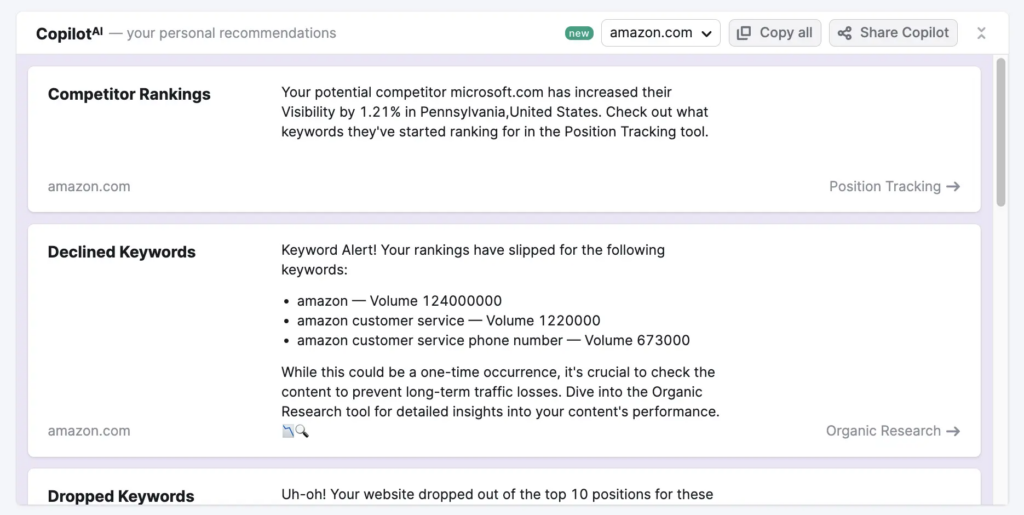
It offers insights and recommendations for organic search and other areas based on six Semrush tools at a time, acting like a personal consultant for your SEO and marketing needs.
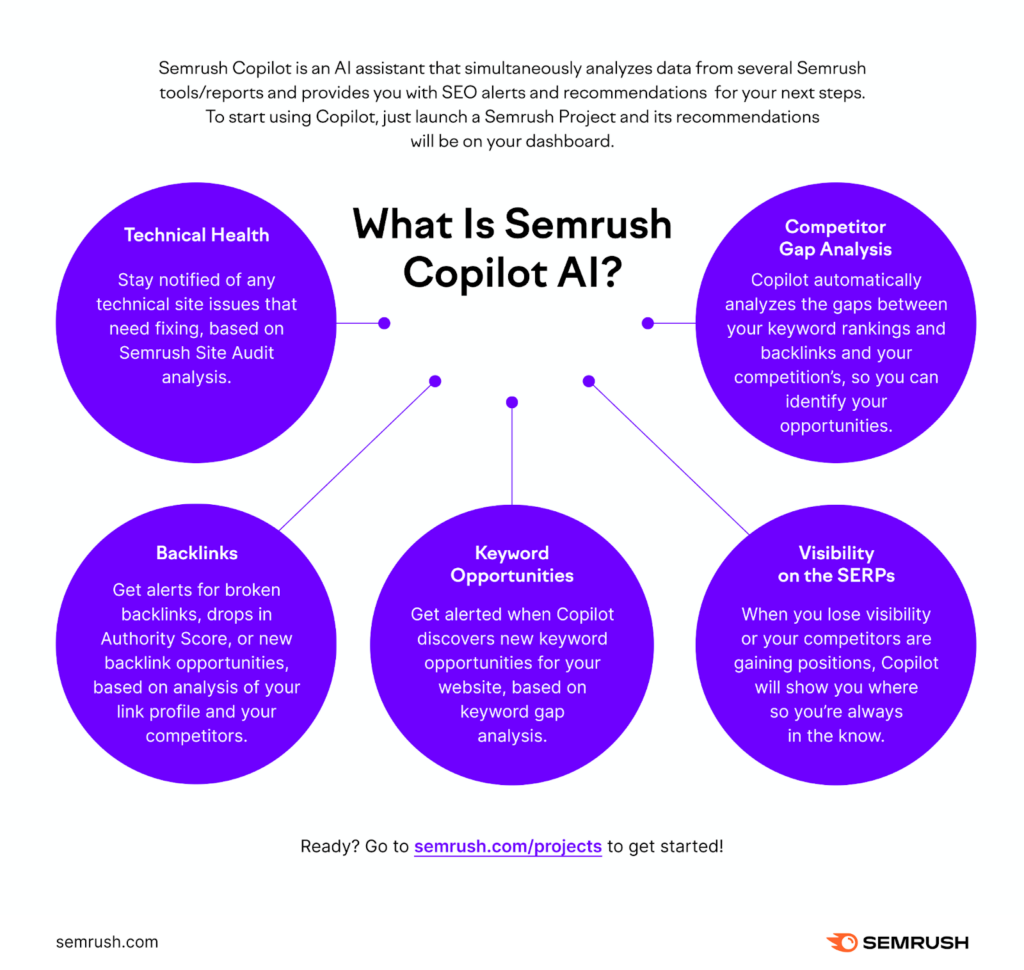
Tracking and Analyzing SEO Metrics with Google Analytics
Google Analytics is a powerful tool that helps you track and analyze your website’s traffic and user behavior.
To effectively track and analyze SEO metrics with Google Analytics, you need to set up goals and events that align with your SEO strategy.
Here are some key SEO metrics to track with Google Analytics:
Organic Search Traffic: This metric shows the number of visitors who come to your website from organic search results. Monitoring organic search traffic helps you understand how well your SEO efforts are driving traffic to your site.
Keyword Rankings: Tracking the position of your website in search engine results pages (SERPs) for specific keywords is essential for measuring the success of your SEO strategy. Higher keyword rankings typically lead to increased visibility and traffic.
Search Volume: This metric indicates the number of searches for a specific keyword or phrase. Understanding search volume helps you prioritize keywords that have the potential to drive significant traffic to your site.
Bounce Rate: The bounce rate is the percentage of visitors who leave your website immediately after arriving. A high bounce rate may indicate that your content is not meeting user expectations or that there are technical issues on your site.
Average Session Duration: This metric measures the amount of time visitors spend on your website. Longer session durations generally indicate that users find your content engaging and valuable.
To analyze these metrics, you can use Google Analytics to create custom reports and dashboards that provide a comprehensive view of your website’s performance.
By regularly monitoring these metrics, you can identify areas for improvement and make data-driven decisions to enhance your SEO strategy.
Creating Custom Reports with Databox
Creating custom reports with Databox is a powerful way to visualize and track your SEO data.
By connecting your Semrush account to Databox, you can create custom dashboards that include the metrics that matter most to you, such as keyword rankings and organic traffic.
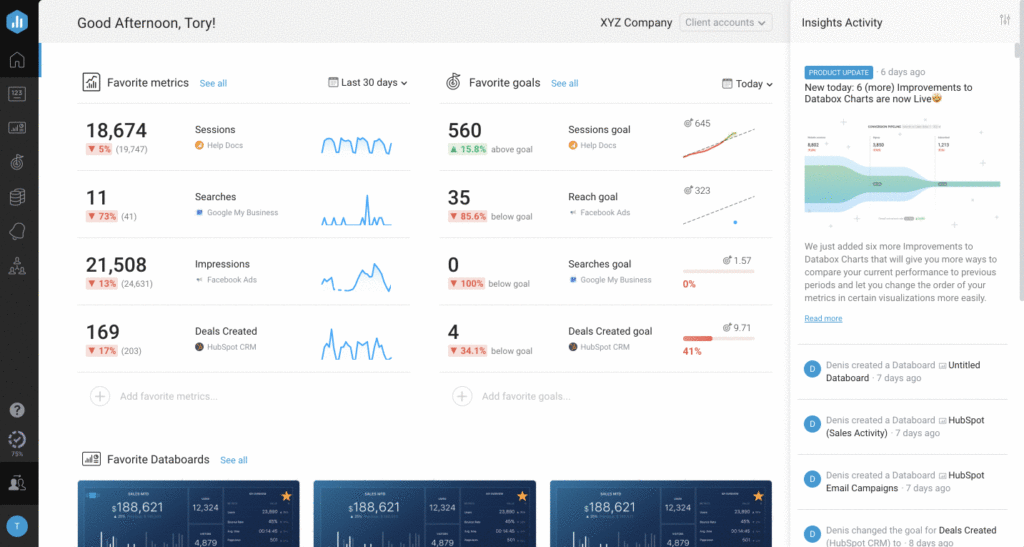
Here’s how to get started:
Connect Your Semrush Account: Begin by linking your Semrush account to Databox. This integration allows you to pull in data directly from Semrush.
Choose Your Metrics: Select the key metrics you want to track. This could include keyword rankings, organic traffic, backlinks, and more.
Create a Custom Dashboard: Use Databox to create a custom dashboard that displays your chosen metrics. You can add widgets, charts, and tables to visualize your data.
Customize Your Dashboard: Tailor the dashboard to your needs by adjusting the layout and design. Add filters to focus on specific data points.
Share with Your Team or Clients: Once your dashboard is set up, you can easily share it with your team or clients. This ensures everyone stays informed and aligned on your SEO progress.
By creating custom reports with Databox, you can easily track your SEO performance and make data-driven decisions to enhance your online presence.
Competitive Research
Semrush’s Competitive Research tools can reveal insights into:
Which keywords your rivals rank for
Where their traffic comes from (organic, paid, social, etc.)
How they’re spending on PPC ads
Analyzing competitors’ PPC strategies can significantly improve your own PPC campaigns. It’s crucial to refine PPC campaigns by assessing competitor performance, ad spending, and keyword bidding patterns.
Conducting an SEO audit can help you understand your competitors’ strengths and weaknesses.
Domain Overview
Domain Overview provides a bird’s-eye view of any domain’s authority score, organic traffic, paid search traffic, and backlinks. You can:

See the domain’s top paid and organic keywords and analyze traffic sources like organic search.
Identify its main competitors.
Examine referring domains and indexed pages.
Use the Compare domains feature to analyze multiple sites side-by-side.
Enhance your search visibility by using the Domain Overview to analyze competitors’ strengths and weaknesses.
Traffic Analytics

Provides estimates on a site’s overall traffic and user engagement metrics. You can see:
Monthly traffic estimates
Average session duration
Page views per visit
Bounce rate
It even details top traffic sources, which sites send them the most traffic, and the social media platforms driving visits, including organic search.
Organic Research
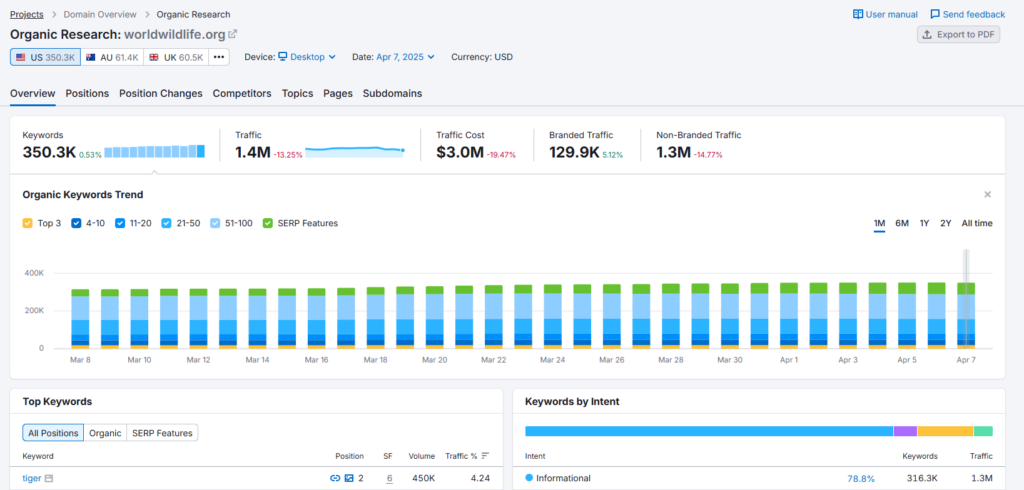
The Organic Research tool shows:
All the keywords a domain ranks for in organic search
Where it ranks for each keyword
Estimated traffic from each keyword
Keyword difficulty, CPC, and intent
It’s perfect for competitor analysis and also aids in keyword discovery.
Keyword Gap

Keyword Gap reveals the keywords that up to four competitors rank for, showing you which terms might be worth adding to your own SEO strategy through organic search opportunities analysis.
Backlink Gap

Backlink Gap compares the backlink profiles of multiple competitors. It’s particularly useful for link-building: you’ll find domains that link to multiple competitors, indicating a higher likelihood they might link to you.
Conducting an SEO audit can help identify link-building opportunities.
Keyword Research
Semrush’s keyword tools tap into a database of 25+ billion search terms for organic search.
This deep well of data lets you discover new opportunities and refine your keyword strategy. Understanding the impact of a particular keyword on traffic is crucial for visualizing patterns in user engagement over time.
Semrush enhances the keyword research process with its tools, allowing you to filter by keyword difficulty and search intent, and track website rankings in search engine results pages (SERPs).
Keyword Overview
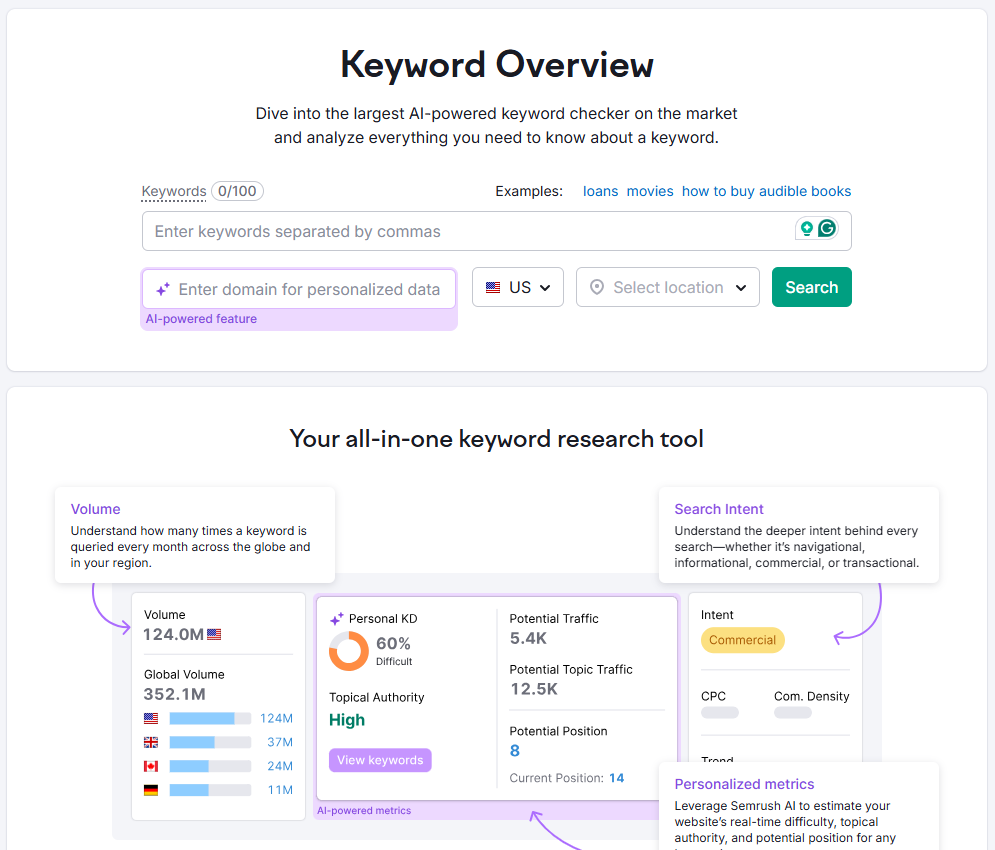
Enter a keyword to see:
Search volume, global volume, and organic search analysis
Keyword difficulty and intent
CPC and competitive density
SERP analysis (who currently ranks, and how strong they are)
Related questions and variations
The tool tracks keyword metrics to provide insights and analyses based on the target keyword to help tailor content strategies. It also helps identify the best keywords for optimization.
You can enter your domain along with your keywords for personalized metrics, like potential traffic.
Keyword Magic Tool
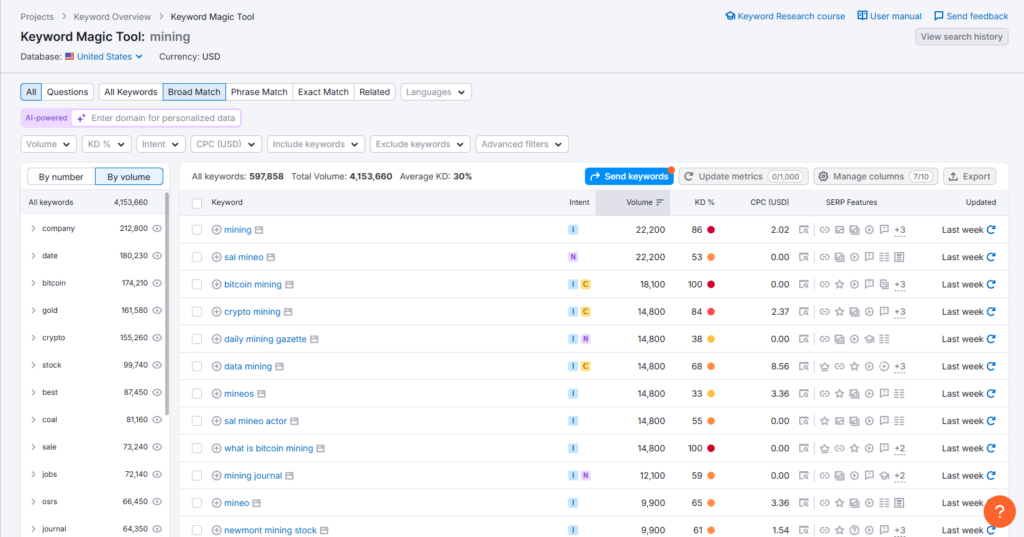
If you need a large volume of keyword ideas for organic search, the Keyword Magic Tool is your best friend. It organizes keyword suggestions by:
Match type (broad, phrase, exact, related)
Keyword groups and subgroups
Filters for search volume, keyword difficulty, CPC, and more
You can also find question-based keywords, useful for long-tail queries and content ideas.
Keyword Strategy Builder
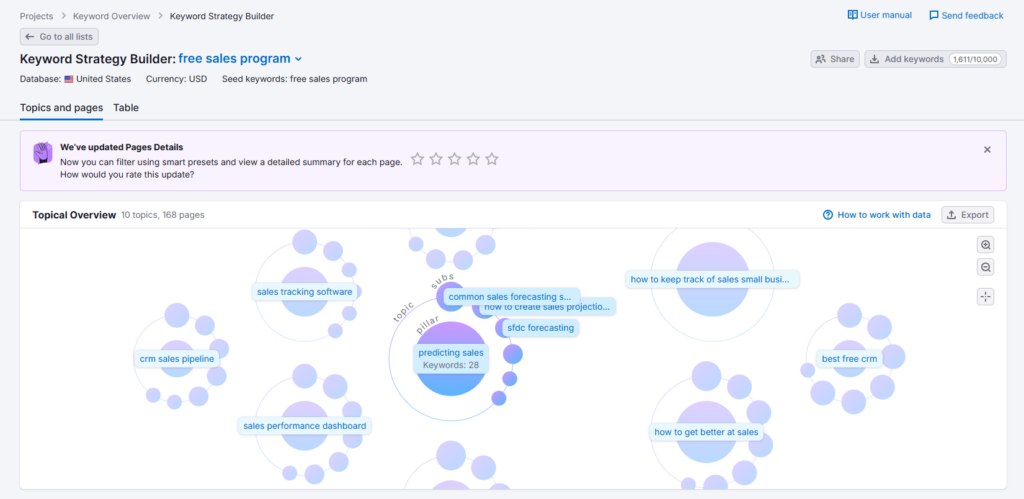
The Keyword Strategy Builder (previously Keyword Manager) helps you transform a list of keywords into content plans for organic search by suggesting pillar pages and cluster pages. This is great for topic clustering.
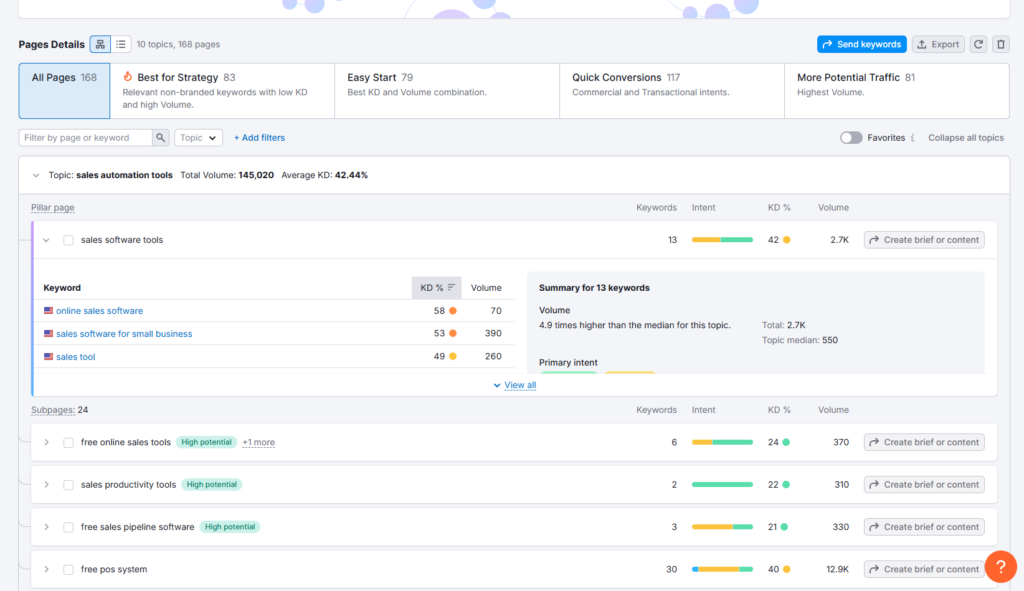
Identifying Long-Tail Keywords
Identifying long-tail keywords is a crucial step in any SEO strategy. Long-tail keywords are specific phrases that have lower search volumes but are less competitive, making them easier to rank for. Here’s how to identify long-tail keywords using Semrush:
Use the Keyword Magic Tool: Start by entering a broad keyword into the Keyword Magic Tool. This tool will generate a list of related keywords.
Filter by Search Volume and Competition: Use filters to narrow down the results. Look for keywords with lower search volumes but still relevant to your business.
Identify Relevant Keywords: Focus on keywords that are specific to your niche and have clear search intent.
Conduct Keyword Gap Analysis: Use the Keyword Gap Analysis tool to find gaps in your keyword strategy. This tool compares your keywords with those of your competitors, revealing opportunities you might have missed.
Create Targeted Content: Develop content that targets the long-tail keywords you’ve identified. This can help attract more specific and relevant traffic to your website.
By targeting long-tail keywords, you can improve your chances of ranking higher in search engine results pages and driving more qualified traffic to your site.
Position Tracking
Semrush’s Position Tracking helps you monitor your site’s rankings for specific keywords in organic search across various devices and locations. It provides data on:
Visibility in the SERPs
Estimated traffic
Average position
Position changes over time
Position tracking is crucial for analyzing competitors’ strengths and weaknesses through various metrics, including keyword rankings and backlink data, to optimize the potential for increased search visibility.
Ideal for keeping tabs on your SEO progress.
Organic Traffic Insights
Combines data from Google Search Console, Google Analytics, and Semrush to show:
Top landing pages
Organic search traffic
Keywords you rank for (including those hidden in GA as “not provided”)
The Organic Traffic Insights tool is particularly useful for uncovering quick-win opportunities outside of core keyword focus areas, providing a comprehensive dashboard that aggregates data from these sources.
It’s a robust way to see pre-click metrics like impressions and rankings, alongside post-click metrics like goal completions.
Link Building
The Link Building tools in Semrush help with backlink audits and prospecting. You can analyze link profiles, discover toxic backlinks, and find new opportunities. Conducting an SEO audit can help analyze link profiles and identify opportunities.
Backlink Analytics
This section shows the:
Total number of backlinks
Referring domains
Authority Score of linking pages
Use it for competitor link analysis or to check your own domain’s backlink profile through organic search.
Backlink Audit
Semrush’s Backlink Audit checks your link profile for:
Toxic links (spammy or dangerous) identified through an SEO audit
Potentially toxic links
Breakdown of your best and worst backlinks
By integrating your Google Search Console account with the Backlink Audit tool, you can access the most recent data regarding your backlinks, essential for maintaining and enhancing SEO rankings.
You can even disavow harmful links directly from the tool.
Link Building Tool
Gathers potential link opportunities based on keywords, organic search, and competitor backlink profiles. Features include:
Prospect List: Potential sites to contact
Outreach module: Email templates for link requests
Link Monitoring: Tracks the status of gained backlinks
Bulk Analysis
Quickly compare up to 200 URLs at once for a high-level backlink overview of each domain as part of an SEO audit.
Finding and Building High-Quality Backlinks
Backlinks are links from other websites to your website, and they play a crucial role in SEO. High-quality backlinks indicate to search engines that your website is authoritative and trustworthy, which can improve your search engine rankings.
To find and build high-quality backlinks, you can use tools like Semrush to analyze your competitors’ backlinks and identify opportunities. Here are some effective strategies for building high-quality backlinks:
Competitor Analysis: Use Semrush’s backlink analysis tool to examine your competitors’ backlink profiles. Identify the websites that are linking to your competitors and reach out to them with compelling reasons why they should link to your content as well.
Guest Blogging: Writing guest posts for reputable websites in your industry is a great way to earn high-quality backlinks. Ensure that your guest posts provide valuable information and include a link back to your website.
Broken Link Building: Identify broken links on other websites and offer your content as a replacement. This strategy not only helps you earn backlinks but also provides value to the website owner by helping them fix broken links.
Content Creation: Create high-quality, shareable content that naturally attracts backlinks. This could include in-depth guides, infographics, research studies, and other valuable resources that people want to link to.
Building high-quality backlinks offers several key benefits:
Improved Search Engine Rankings: High-quality backlinks can help you rank higher in search engine results pages (SERPs), driving more organic traffic to your website.
Increased Authority: Backlinks from reputable websites signal to search engines that your website is authoritative and trustworthy.
Better Content Optimization: High-quality backlinks help you create content that is more relevant and useful to your target audience, enhancing your overall SEO strategy.
By implementing these strategies, you can build a strong backlink profile that boosts your search engine rankings and drives more traffic to your website.
Creating a Link Building Strategy
Creating a link building strategy is essential for improving your website’s authority and search engine rankings. Here’s how to develop an effective link building strategy using Semrush:
Analyze Competitors’ Backlinks: Use the Backlink Analytics tool to examine your competitors’ backlink profiles. Identify the sources of their backlinks and the types of content that attract links.
Identify Gaps and Opportunities: Look for gaps in your own link profile and opportunities for improvement. This could include targeting websites that link to your competitors but not to you.
Create High-Quality Content: Develop content that is valuable and shareable. High-quality content naturally attracts backlinks from other websites.
Outreach for Links: Reach out to other websites and ask for links. Provide compelling reasons why they should link to your content, such as its relevance and value.
Track Your Progress: Use the Link Building tool to monitor your link building efforts. Track new backlinks, outreach responses, and overall progress.
By creating a link building strategy, you can enhance your website’s authority and improve your search engine rankings.
On Page & Tech SEO
Semrush also offers tools for SEO audit as part of its technical site audits and on-page optimization. Maintaining technical SEO health is crucial for overall site performance. Using a site audit tool can help identify and fix technical issues, ensuring your website remains optimized and error-free.
Site Audit
Automated SEO site audits to detect issues like:
Broken links
Duplicate content
Slow page speed
Tracks “site health” over time, so you can measure improvements.
On Page SEO Checker
Provides suggestions to refine your on-page elements for better organic search results:
Title and meta tag improvements
Use of semantically-related keywords
Potential backlink sources
Log File Analyzer
Helps you see exactly how search engine bots crawl your website during an SEO audit, identifying pages with low crawl frequency and potential crawl budget issues.
On-Page SEO Checklist
On-page SEO is a critical component of any SEO campaign. Here’s a checklist of on-page SEO elements to optimize for better search engine rankings:
Title Tags: Write unique and descriptive title tags for each page. Include your target keywords to help search engines understand the content.
Meta Descriptions: Craft compelling and informative meta descriptions for each page. These should entice users to click on your link in the search results.
Header Tags: Use header tags (H1, H2, H3) to structure your content and highlight important keywords. This helps search engines understand the hierarchy of your content.
Image Alt Tags: Use descriptive alt tags for each image. This not only helps with SEO but also improves accessibility.
Internal Linking: Use internal linking to connect related content on your website. This helps search engines understand your site’s structure and improves user navigation.
Content Optimization: Optimize your content for target keywords and phrases. Ensure your content is relevant, informative, and engaging.
Mobile-Friendliness: Ensure that your website is mobile-friendly and responsive. A mobile-friendly site provides a better user experience and is favored by search engines.
Page Speed: Optimize your website’s page speed to improve user experience. Faster-loading pages are more likely to rank higher in search results.
By optimizing these on-page SEO elements, you can improve your website’s search engine rankings and drive more traffic.
Optimizing for User Experience
Optimizing for user experience is a vital aspect of any SEO campaign. A positive user experience can lead to higher engagement, lower bounce rates, and better search engine rankings. Here’s how to optimize for user experience:
Analyze User Experience: Use the User Experience tool to analyze your website’s user experience. Identify areas that need improvement, such as page speed and mobile-friendliness.
Improve Website Structure and Navigation: Ensure your website’s structure and navigation are intuitive and user-friendly. Clear menus and easy-to-find information enhance the user experience.
Use Clear and Concise Language: Write content that is easy to read and understand. Avoid jargon and use clear, concise language.
Enhance with Images and Videos: Use images and videos to make your content more engaging. Visual elements can help break up text and keep users interested.
Test and Iterate: Continuously test and iterate on your website’s user experience. Use tools like A/B testing to find what works best for your audience.
By optimizing for user experience, you can improve your website’s search engine rankings and drive more traffic.
Local SEO
For local businesses, Semrush’s Local SEO toolkit streamlines your approach to Google Business Profile optimization, local listings, and organic search. A well-implemented local SEO strategy is crucial for improving local search performance.
GBP Optimization
Once you connect your Google Business Profile (GBP), you can:
Track profile performance, including organic search metrics
Get suggestions for improvements
Listing Management
Semrush can sync your business info (NAP data) across 70+ directories (U.S.) or 40+ international ones, reducing inconsistencies, boosting local visibility, and enhancing organic search.
Map Rank Tracker
Shows a heatmap of your rankings at street-level precision. Compare your domain’s local performance, including organic search, to competitors in the same area.
Review Management
Collects all your directory reviews in one place, making it easier to respond and track your online reputation through organic search.
PPC Advertising
Semrush excels at competitive PPC research and organic search analysis, with tools like Advertising Research, AdClarity, PLA Research, Ads History, and more.
Using an advertising research tool to analyze competitors’ PPC performance, including ad spending, successful ad copies, and keyword strategies, can significantly enhance your campaigns.
Additionally, optimizing a google ads campaign through various tools designed to enhance performance and effectiveness is crucial for success.
Advertising Research
See the keywords your competitor bids on, analyze their organic search performance, how much they might be spending, and the ad copy they use.
AdClarity (App)
Offers insights into competitor ad campaigns across multiple platforms, including organic search, ad creatives, spend, and impressions.
PLA Research
Analyzes Google Shopping ads and organic search:
Which keywords competitors use
How they position their products
Their product pricing
Ads History
View a 12-month overview of competitors’ ads for a given keyword, including rank changes, traffic estimates, and insights from organic search analysis.
Ads Launch Assistant (App)
Uses AI to generate ad copy suggestions from organic search, relevant keywords, and monitors results once live.
Social Media
Semrush also provides a robust toolkit for social media scheduling, organic search, analytics, and competitor tracking.
Social Poster
Schedule and publish posts to major platforms, including Instagram, Facebook, X (Twitter), Pinterest, LinkedIn, and Google Business Profile.
Social Tracker
Monitor your social performance alongside competitors.
Posting frequency
Follower growth
Engagement metrics
Social Content Insights
Tag and track your posts, analyzing engagement across multiple platforms.
Social Analytics
In-depth look at data like:
New followers
Post reach
Top engagement times
Using a review management tool to monitor and respond to reviews on platforms like Google Business Profile can also enhance your online reputation.
Social Content AI
AI-generated social post ideas and copy, saving time for busy marketers.
Influencer Analytics
Find influencers based on:
Follower count
Engagement rate
Estimated cost
Even see if competitors run influencer campaigns.
Content Marketing
Semrush’s Content Marketing Toolkit offers solutions for topic ideation, content optimization, and content performance tracking.
Topic Research
Generates topic ideas and subtopics for your blog posts and articles. Perfect for brainstorming and content planning.
SEO Content Template
Helps you craft SEO-friendly content by suggesting:
Semantically related keywords
Recommended text length
Readability score
Backlink opportunities
Semrush’s SEO Content Template helps create SEO-friendly content by automatically generating a comprehensive framework based on target keyword analysis.
SEO Writing Assistant
Analyzes your content in real-time for readability, keyword usage, and plagiarism checks. Also integrates with Google Docs, MS Word, and WordPress.
Brand Monitoring
Tracks brand mentions across the web and social channels—handy for reputation management and finding unlinked brand mentions.
ContentShake AI (App)
Generates AI-driven content ideas and can produce draft copy. Offers advanced editing with rephrase, shorten, or expand options.
Semrush .Trends
Semrush .Trends helps you understand broader market behavior and analyze competitor strategies.
Market Explorer
Shows key players in your market, along with traffic share, demographics, audience behaviors, and social media platforms your audience frequents. Using the Market Explorer, you can monitor your website’s online presence to gain insights into visibility and performance.
EyeOn
Keeps tabs on your rivals’ latest posts, updates, and social activity so you can spot shifts in their strategies.
One2Target
Goes deep into your audience’s:
Age, sex, and location
Household size, income, and education
Social media preferences
Use these insights to tailor your marketing campaigns.
Agency Solutions
Designed for agencies looking to manage clients and scale.
Agency Partners Platform
A directory where businesses find relevant agencies. You can create a profile to showcase your services.
Lead Finder
Searches for potential clients based on location and web technologies they use. Useful for discovering leads aligned with your offerings.
Client Portal & CRM
Manage client work in one place with checklists and updates. The Client Portal allows clients to see real-time project progress, even if they’re not Semrush users.
My Reports
Create custom or template-based PDF reports using data from Semrush, Google Analytics, Search Console, and other sources. White-label these for a professional touch.
Semrush App Center
In addition to built-in tools, Semrush also hosts a library of apps to extend functionality. Popular categories include:
AI apps for ad creatives and store SEO
Local business apps for listing checks
YouTube analytics apps
Many of these apps are free or offer trials.
Who Is Semrush For?
Whether you’re an SEO pro, digital marketing agency, PPC advertiser, social media manager, or ecommerce business owner, Semrush can handle the full scope of your online marketing and competitive analysis needs.
Semrush Pricing Plans
There are three main pricing tiers:
Pro: $139.95/month
Guru: $249.95/month
Business: $499.95/month
Each plan offers different limits on data usage and features. Some toolkits (like .Trends) and add-ons come with separate fees. Semrush also has a free plan with limited functionality and paid plan trials.
Add-ons
Local: $20-$40/month
.Trends: $289/month (per user)
Social Media Management: $29.99/month
Agency Growth Kit: $69-$249/month
ImpactHero: $200/month
Try Semrush for Yourself
Semrush has helped 116,000+ paying customers improve their search rankings, keyword strategies, and entire digital marketing campaigns. You can explore many of these features with a free plan or dive deeper with a 14-day free trial of Semrush Pro.
Ready to see how Semrush can optimize your online presence? Give Semrush a try and let the data guide your digital marketing strategy.
